Contents
What Does it Mean to be Human?
Cultural Perspective
What constitutes being human? Many will point at a cultural identity and leaving long-standing remnants of that culture. Such prehistorical artifacts like cave drawings and tools provide an anthropological framework for identifying what it is to be human, but the biological identity remains locked in the history of our DNA.
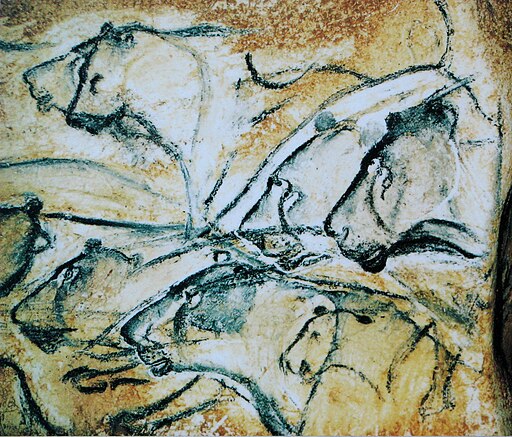
- Humans are defined by their ability to create complex culture and societies, including art, language, music, literature, philosophy, etc.
- Culture allows humans to communicate symbolic meaning, establish social bonds, and accumulate knowledge across generations.
- Humans have expanded capacity for abstract thought compared to other animals.
- Morality, ethics, spirituality are integral parts of the human experience across cultures.

Anthropological Perspective
- Homo sapiens evolved from earlier hominins approximately 300,000 years ago in Africa.
- Bipedalism, enlarged brains, opposable thumbs, and development of language set early humans apart.
- Use of tools, control of fire, and complex social structures emerged in human evolution.
- Anthropology studies human cultural/biological diversity and evolutionary history.
Evolutionary Perspective
- Humans share a common ancestor with great apes about 6 million years ago.
- Evolution of larger brain size, cognition, and group living in early hominins drove selection for human traits.
- Humans adapted to diverse environments by developing culture, technology, and complex cooperation.
- Many human behaviors and psychological tendencies have evolutionary bases.
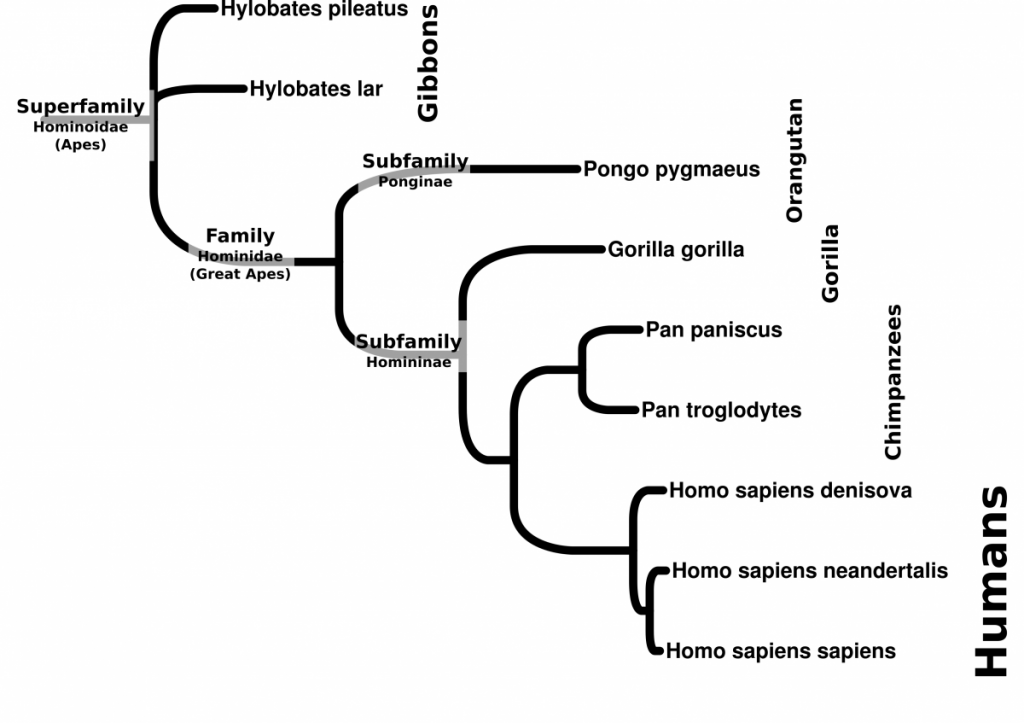
Phylogenetic tree generated with Cytochrome Oxidase I (COI) genes. 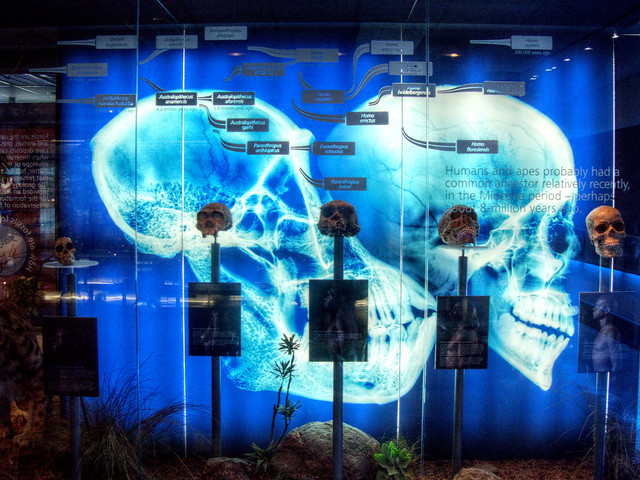
The Pan-Homo divergence. A display at the Cradle of Humankind illuminates the skulls of two extant Hominini with a series of model fossils from the Hominina subtribe of Austrolopithecina and Homo. Credit: Jeremy Seto [CC-BY-NC-SA] https://flic.kr/p/SmhHTd
Genomic Perspective
- The human genome contains about 20,000 protein-coding genes.
- Genes influence human behaviors, cognition, disease risk, physical traits.
- Comparative genomics reveals that humans genetically similar to other great apes (~98% DNA similarity with chimpanzees).
- Modern genomics aims to further understand genetic contributions to human health and diversity.
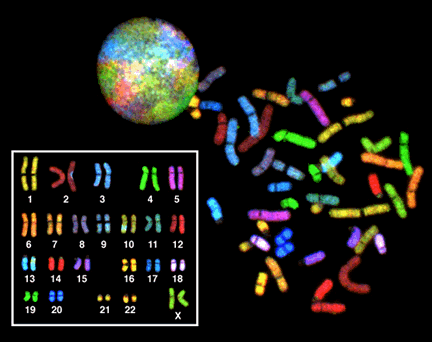
Homo sapiens represent a branch of primates in the line of Great Apes. The family of Great Apes consists of four extant genera: Homo, Pan, Gorilla, Pongo. Karyotype analysis (Yunis et al., 1982) reveals a shared genomic structure between the Great Apes. While humans have 46 chromosomes, the other Great Apes have 48. Molecular evidence at the DNA level indicates that Human Chromosome 2 is a fusion of 2 individual chromosomes. In the other Great Apes, these 2 Chromosomes are referred to as 2p and 2q to illustrate their synteny to the human counterpart.

| Perspective | Key Points |
|---|---|
| Cultural | Art, language, symbolic thinking, morality |
| Anthropological | Tool use, bipedalism, social structures |
| Evolutionary | Cognition, cooperation, adaption, behavior |
| Genomic | 20,000 protein-coding genes, great ape genetic similarity |
The Concept of a Gene
The concept of a gene has evolved over time, from a simple functional unit to a complex, dynamic system.
Early Concept
- Proposed by Beadle & Tatum
- One gene encodes one enzyme
- Gene as discrete functional unit controlling a trait
George Beadle and Edward Tatum first used x-rays on the yeast Neurospora crassa to generate mutants that were deficient in various metabolic pathways which resulted in the description of the “one gene, one enzyme hypothesis“(Beadle & Tatum, 1941).

Dawkins’ Selfish Gene
- Gene as a replicator unit acting to propagate itself
- Organisms are just “vehicles” for gene replication
- Genes are “selfish” – evolve for self-propagation, not benefit to organism
Modern View
- Gene function depends on regulators, splicing, genetic background
- Gene influences multiple traits via pleiotropy
- Environment affects gene expression
- Genes work in networks, not isolation
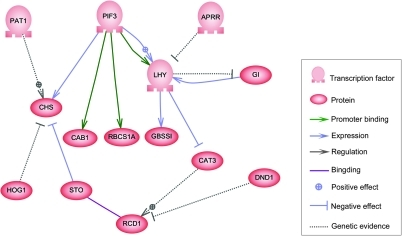
Cultural Replicators
In the context of cultural evolution and online culture, the term “meme” refers to an idea, behavior, style, or cultural practice that spreads within a culture. Richard Dawkins coined this term in “The Selfish Gene,” to refer to units of cultural transmission or imitated behaviors.
In the digital age, especially with the rise of the internet and social media, the meaning of “meme” has evolved. Online memes are typically humorous images, videos, pieces of text, or even hashtags that are rapidly spread and modified by internet users. They often convey a cultural idea, joke, or reference and are shared widely across online platforms.

Key characteristics of memes include:
- Imitation and Replication: Memes are shared through imitation. Users replicate and share them with others, leading to the widespread dissemination of cultural elements.
- Cultural Transmission: Memes represent a form of cultural transmission, where ideas or behaviors are passed from one individual to another through imitation and sharing.
- Evolution and Variation: Memes can evolve and undergo variations as they are shared and modified by different individuals. This evolution is driven by user creativity and the changing cultural context.
- Humor and Satire: Many memes are designed to be humorous or satirical. They often rely on shared cultural references and inside jokes to resonate with a specific audience.
- Internet Culture: Online memes are closely associated with internet culture and social media platforms. They are a way for individuals to engage in online communities and express shared sentiments.
- Short-Lived Nature: Memes can have a relatively short lifespan. They may become viral and widely shared for a brief period before fading away as new memes emerge.
Selfish Genetic Replicators
A transposon, also known as a “jumping gene” or a “mobile genetic element,” is a DNA sequence that has the ability to change its position within a genome. Transposons are found in the DNA of organisms ranging from bacteria to plants and animals, including humans. They play a significant role in genetic diversity, evolution, and genome structure.
Transposons are often referred to as “selfish genetic elements” because their primary function is to ensure their own replication and transmission within the host genome. They may not confer an immediate advantage to the host organism.
Transposons can be autonomous or non-autonomous. Autonomous transposons encode their own transposase enzyme that facilitates the jumping of the gene while non-autonomous transposons require the transposase activity of another transposable element. Functional DNA transposons are autonomous and work through a “cut and paste” mechanism. DNA transposons are delineated by flanking terminal repeats that mark the location that the transposase excises the DNA. These DNA elements then re-integrate at a different location within the genome. The excision from DNA leaves marks of these flanking repeats that can be used to study the rate and level of DNA transposition events within a genome. The insertion of these transposons can effect the expression of nearby genes and can completely disrupt genes they land into as evidenced in the speckled corn kernels that McClintock described.
RNA transposons are called retrotransposons because they are transcribed into an mRNA and require a reverse transcription to integrate into the genome. The most common mobile element in the human genome are the Long Interspersed Nuclear Elements (LINEs) and the Short Interspersed Nuclear elements (SINEs). These retrotransposons are most abundantly represented by the autonomous LINE1 (L1) and non-autonomous Alu elements, respectively. Alu elements rely on the expression of the L1 in order to be reverse-transcribed and integrated into the genome. These retrotransposons work in a “copy and paste” mechanism and are responsible for genomic expansion. As their classifications signify, LINEs are longer than SINEs. This is due to the presence of a second reading frame that encodes the transposase.

Evolutionary Success of Replicators
Dawkins proposed that evolution works through differential replication of “selfish” genes, memes or other replicators.
Examples of Successful Replicators
- Genes – Successful genes become more abundant in gene pool
- Memes – Successful ideas spread more widely in culture
- Transposons – “Jumping genes” like ALUs multiply in genome
| Replicator | Propagation Mechanism | Evolutionary Success |
| Gene | Biological reproduction | Increased frequency in population |
| Meme | Imitation | Increased frequency in culture/media |
| Transposon | Self-replication within genome | High copy numbers |
Drivers of Replicator Success
- Enhanced survival
- Efficiency of replication mechanisms
- Competitive advantage over other replicators
What Makes Us Human?
Evidence Against Genetic Determinism
Humans are more than just “vehicles” for genetic replication.
- High cognitive abilities not strongly genetically determined
- Culture has huge influence on behavior
- Environmental factors affect gene expression
Moderately Unique Characteristics of Humans
- Large, complex brain
- Language and abstract thought
- Cumulative culture and technology
- Morality, empathy, love
While genes influence human traits, we are also shaped by developmental, social and cultural factors. Human nature cannot be reduced solely to the action of “selfish replicators.”
The relationship between memes and the diffusion of innovation lies in their shared role in spreading and adopting new ideas, behaviors, or cultural elements within a society.
- Information Transmission:
- Memes: Memes, in the cultural sense, are units of cultural information that spread through imitation and communication. They can include ideas, behaviors, symbols, or any cultural element that is transmitted from person to person.
- Diffusion of Innovation: In the context of innovation, the diffusion process involves the spread of new technologies, products, or practices within a social system. It focuses on how innovations are communicated through channels over time.
- Adoption and Spread:
- Memes: Memes rely on individuals adopting and spreading the cultural elements they embody. The success of a meme depends on its ability to resonate with individuals and be shared through various channels.
- Diffusion of Innovation: This process involves the adoption and spread of innovations through a population. Innovations typically follow a diffusion curve, with different groups of people adopting them at different stages—innovators, early adopters, early majority, late majority, and laggards.
- Communication Channels:
- Memes: Memes often spread through social media, word of mouth, and other communication channels. They leverage human connections and social networks for propagation.
- Diffusion of Innovation: Communication channels for innovation diffusion can include mass media, interpersonal communication, and various social networks. The channels play a crucial role in the awareness and acceptance of innovations.
- Cultural Impact:
- Memes: Memes contribute to the shaping of cultural norms, behaviors, and attitudes. They can influence how individuals perceive and respond to certain ideas or events.
- Diffusion of Innovation: The diffusion process can lead to changes in societal practices, norms, and structures. The widespread adoption of innovations can impact how a society functions.
Memes and the diffusion of innovation involve the transmission and adoption of information within a social system. This replication can be distinguished by memes having a more broad focus on cultural elements, while the diffusion of innovation specifically deals with the adoption of new technologies/practices.
The replicators
| Feature | Selfish Gene (Dawkins) | Viruses | Transposons | Alu Retrotransposons | Memes |
| Genetic Information | Encoded in DNA/RNA | DNA/RNA | DNA | RNA | Information in various forms |
| Replication | Replicates using host cellular machinery | Requires host cell machinery | Autonomous or host-assisted mobility | Retrotransposition (copy-paste mechanism) | Replicated through human communication and imitation |
| Evolutionary Impact | Influences the survival and reproduction of genes | Can shape host evolution | May contribute to genetic diversity and evolution | Can impact gene regulation and genome evolution | Cultural evolution and transmission |
| Selfish Nature | Emphasizes the gene-centric view of evolution | Exploits host resources for replication | May move within or between genomes for own benefit | Propagate themselves within the genome | Spread and persist based on cultural fitness |
| Relationship with Host | Part of host organism | Parasitic relationship with host | May be integrated into host genome or move independently | Integrated into host genome | Exists in the minds and behaviors of individuals |
| Adaptation to Environment | Subject to natural selection | Evolve to exploit host environment | Impact on host genome evolution | Influence gene regulation and expression | Adapt and spread based on cultural relevance |
| Role in Evolutionary Processes | Proposes genes as central units of selection | Can drive evolutionary changes in host populations | Can lead to genomic rearrangements and evolution | Contribute to genomic diversity and regulatory networks | Shapes cultural evolution and societal behaviors |



